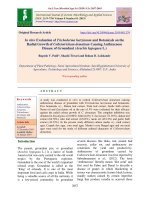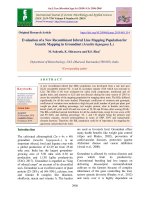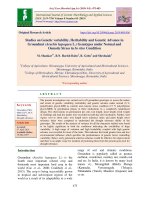Variability studies for quantitative traits in F3 generation of groundnut (Arachis hypogaea L.)
Bạn đang xem bản rút gọn của tài liệu. Xem và tải ngay bản đầy đủ của tài liệu tại đây (150.12 KB, 9 trang )
Int.J.Curr.Microbiol.App.Sci (2017) 6(4): 1326-1334
International Journal of Current Microbiology and Applied Sciences
ISSN: 2319-7706 Volume 6 Number 4 (2017) pp. 1326-1334
Journal homepage:
Original Research Article
/>
Variability Studies for Quantitative Traits in F3 Generation of
Groundnut (Arachis hypogaea L.)
R. Divyadharsini, R. Prabhu*, N. Manivannan and P. Vindhiyavarman
Department of Oilseeds, Centre for Plant Breeding and Genetics,
Tamil Nadu Agricultural University, Coimbatore - 641 003, Tamil Nadu, India
*Corresponding author
ABSTRACT
Keywords
Groundnut, Mean,
Variability,
Population
distribution, Yield,
Late leaf spot, Rust.
Article Info
Accepted:
12 March 2017
Available Online:
10 April 2017
In the present investigation, estimates of genetic variability, heritability and genetic
advance were assessed for nine different characters in the F3 population derived from four
groundnut crosses, viz., CO 7 × VRI Gn 6, TMV 2 × VRI Gn 6, TMV Gn 13 × VRI Gn 6
and VRI 2 × VRI Gn 6. Considering the mean performance, the cross derivative TMV Gn
13 × VRI Gn 6 registered superiority for the characters viz., 100-pod weight (g), 100kernel weight (g) and sound mature kernel (%). Apart from these characters, the cross VRI
2 × VRI Gn 6 for shelling (%) and sound mature kernel (%), and CO 7 × VRI Gn 6 for the
trait late leaf spot and rust score also showed higher mean performance. High percentage
of PCV, GCV, heritability coupled with high GAM values were recorded by number of
pods plant-1, pod yield plant-1 (g), kernel yield plant-1 (g), late leaf spot score and rust score
in varied crosses. Selection would be effective for these traits in respective crosses to
obtain promising progenies. Regarding the population distribution, significant and negative
skewness was observed in all the four crosses for shelling (%) and sound mature kernel
(%). Leptokurtic/mesokurtic nature was noticed in most of the traits understudy. Thereby,
directional selection will effectively improve the mean performance of these traits. Hence,
based on mean and various genetic parameters, the cross CO 7 × VRI Gn 6 is considered
as superior for late leaf spot and rust resistance in groundnut.
Introduction
Groundnut (Arachis hypogaea L.) is an
important food and cash crop for resourcepoor farmers in Asia and Africa and it can be
consumed and utilized in diverse ways
(Thirumala et al., 2014). India is the second
largest producer of groundnut after China
(FAOSTAT, 2013). Groundnut is the largest
oilseed crop in India in terms of production
(Madhusudhana, 2013). Though India ranks
first in production, its productivity is low due
to two major foliar fungal diseases namely,
late leaf spot (Phaeoisariopsis personata) and
rust (Puccinia arachidis) which are
economically very important foliar fungal
diseases of cultivated groundnut and together
they can reduce the yield about 50-70%
(Subrahmanyam et al., 1984). The regular
incidence of these diseases warrants the
development of resistant cultivars by which
we can control not only these diseases but
also improve the production and quality
besides reducing the adverse effects of
chemicals on our ecosystem (Shoba et al.,
2009). The yield is a complex character,
1326
Int.J.Curr.Microbiol.App.Sci (2017) 6(4): 1326-1334
which is highly influenced by environmental
variations (John et al., 2011).
Materials and Methods
Study area
Mean and genetic variability is the basic
requirement for crop improvement as this
provides wider scope for selection
(Vishnuvardhan et al., 2012). Mean serves as
a basis for eliminating undesirable crosses
(Shoba et al., 2012). Information on extent of
genetic variability and role of important yield
determining traits are paramount importance
for their skillful engineering of new ideotype.
The presence of variability in crop is
important
for
genetic
studies
and
consequently used for improvement and
selection (Govindaraj et al., 2015). Thus,
effectiveness of selection is dependent upon
the nature, extent and magnitude of genetic
variability present in material and the extent
to which it is heritable. High GCV values
indicate the greater extent of variability
present in the character and can be improved
through selection. A relative comparison of
heritability estimates and expected GAM will
give an idea about the nature of gene action
governing a particular trait (Anusha and
Savithramma, 2015). High value of
heritability together with high genetic
advance for any character indicates additive
gene action and selection will be rewarding
for improvement of such traits whereas, high
heritability associated with low genetic
advance might attribute to the presence of
non-additive gene action which indicates
dominance/epistasis and their response to
selection would be poor (Bhargavi et al.,
2016).
An insight into the nature and degree of
distribution present in population is of utmost
importance as it forms the basis for selection
in any crop improvement programme (Prabhu
et al., 2015b). Therefore, the present
investigation was undertaken to study
variability, heritability and genetic advance in
four segregating F3 populations of groundnut.
The present scientific investigation was
carried out at Oilseeds Farm, Department of
Oilseeds, Centre for Plant Breeding and
Genetics,
Tamil
Nadu
Agricultural
University, Coimbatore, during Kharif (JuneOctober) 2014.
Experimental material
Groundnut genotypes for the study consisted
of four released/advanced breeding female
parent viz., CO 7, TMV 2, TMV Gn 13 and
VRI 2 and a male parent, VRI Gn 6. The
females are susceptible to foliar fungal
diseases namely late leaf spot and rust.
However, the male parent VRI Gn 6 is
moderately resistant to these diseases. Four
crosses viz., CO 7 × VRI Gn 6, TMV 2 × VRI
Gn 6, TMV Gn 13 × VRI Gn 6 and VRI 2 ×
VRI Gn 6 were made and utilised for the
present study. Selection was done in F2
generation for pod yield, kernel yield and
foliar disease resistance. All the parents and
F3 progenies were evaluated in non-replicated
trial. Recommended cultural practices were
followed throughout the crop growing period.
The spacing adopted was 30 × 10 cm.
Observations recorded
Observations were recorded and analyzed in
terms of mean and variability parameters on
nine characters viz., number of pods plant-1,
100-pod weight (g), 100-kernel weight (g),
shelling (%), sound mature kernel (%), pod
yield plant-1 (g), kernel yield plant-1 (g), late
leaf spot (LLS) and rust disease scores. Nine
point
disease
scale
suggested
by
Subrahmanyam et al., (1995) was used to
screen the lines for source of resistance to late
leaf spot and rust diseases.
1327
Int.J.Curr.Microbiol.App.Sci (2017) 6(4): 1326-1334
Statistical analysis
Standard statistical procedures were adopted
for calculating the mean and various genetic
parameters like phenotypic coefficient of
variation (PCV), genotypic coefficient of
variation (GCV), heritability (h2) in broad
sense and genetic advance as % of mean
(GAM). The range of coefficient of variation
(CV) was categorized as per Sivasubramanian
and Madhavamenon (1973): below 10% Low coefficient of variation; 10-20% Medium coefficient of variation; above 20% High coefficient of variation. As suggested by
Robinson et al., (1949), the heritability range
was classified as: less than 30% - Low
heritability; 30%-60% - Moderate heritability;
more than 60% - High heritability. Similarly,
the range of genetic advance as per cent of
mean (GAM) was grouped as: less than 10% Low GAM; 10%-20% - Medium GAM; more
than 20% - High GAM (Johnson et al., 1955).
Results and Discussion
The results on the mean performance and
various genetic parameters for nine yield and
yield attributes of four segregating
populations viz., CO 7 × VRI Gn 6, TMV 2 ×
VRI Gn 6, TMV Gn 13 × VRI Gn 6 and VRI
2 × VRI Gn 6 are presented hereunder.
Mean performance
Mean performance of parents
In a breeding programme, mean performance
is the foremost important criteria to select an
individual. Among the parents, CO 7 and
TMV 2 recorded superiority for number of
pods plant-1 while, the parent VRI 2 possessed
higher mean value for 100-pod weight (g),
100-kernel weight (g), sound mature kernel
(%), pod yield plant-1 (g) and kernel yield
plant-1 (g). VRI Gn 6 exhibited superior mean
performance for late leaf spot and rust score.
Thus, VRI 2 was considered as desirable
parent for yield improvement and VRI Gn 6
for late leaf spot and rust resistance in
groundnut (Table 1).
Mean performance of crosses
Among the crosses, TMV Gn 13 × VRI Gn 6
recorded superior mean performance for 100pod weight (g), 100-kernel weight (g) and
sound mature kernel (%). The cross VRI 2 ×
VRI Gn 6 exhibited higher mean value for
shelling (%) and sound mature kernel (%)
whereas, the cross CO 7 × VRI Gn 6 for late
leaf spot and rust resistance. Hence,
considering the mean performance, the cross
CO 7 × VRI Gn 6 is considered superior for
late leaf spot and rust resistance. No
significance was observed for remaining traits
in all the crosses.
Variability parameters
In the present study, the phenotypic and
genotypic coefficient of variation exhibited
wide range for all characters. All the four F3
populations exhibited higher PCV values than
the GCV values suggesting the influence of
environmental factors for all the characters
studied. Less difference observed between
PCV and GCV in certain cases indicated
greater role of genetic components and less
influence by environment. Similar results
were obtained by Shinde et al., (2010) and
Prabhu et al., (2015a). The genetic parameters
studied for various characters in F3 generation
(Table 2) are narrated below.
Number of pods plant-1
The cross TMV Gn 13 × VRI Gn 6 alone
exhibited high PCV, GCV, heritability
coupled with high GAM for the trait number
of pods plant-1. Similar results have been
reported by Savaliya et al., (2009), Shinde et
al., (2010), Priyadharsini (2012), Anitha
(2013), John et al., (2013) and Prabhu et al.,
(2015 a). The remaining crosses viz., CO 7 ×
1328
Int.J.Curr.Microbiol.App.Sci (2017) 6(4): 1326-1334
VRI Gn 6, TMV 2 × VRI Gn 6 and VRI 2 ×
VRI Gn 6 recorded high PCV, high GCV,
moderate heritability and high GAM. This is
similar to the findings of John et al., (2013).
100-pod weight (g)
High/medium PCV, medium/low GCV,
heritability and GAM values for 100-pod
weight (g) were recorded by all the four
crosses. Pradhan and Patra (2011), Zaman et
al., (2011), Anitha (2013) and John et al.,
(2013) also reported medium values for the
trait 100-pod weight (g) in groundnut. No
such low values were reported earlier.
100-kernel weight (g)
PCV, GCV, heritability and GAM values
ranged from higher to lower for 100-kernel
weight (g) in all the four crosses under study.
Such estimates of PCV, GCV, heritability and
genetic advance have already been indicated
by John et al., (2013).
Shelling (%)
High PCV, GCV, heritability and medium
GAM values were recorded by the crosses
viz., TMV 2 × VRI Gn 6, TMV Gn 13 × VRI
Gn 6 and VRI 2 × VRI Gn 6 for the trait
shelling (%). Similar results were given by
Anitha (2013) and John et al., (2013). The
cross, CO 7 × VRI Gn 6 exhibited medium
PCV, GCV, high heritability and medium
GAM values. These observations are in
agreement with the findings of Zaman et al.,
(2011).
Sound mature kernel (%)
For sound mature kernel (%), high PCV and
GCV values were recorded in the cross CO 7
× VRI Gn 6. Similar findings were reported
by Hiremath et al., (2011) and Prabhu et al.,
(2015 a) for sound mature kernel (%).
High/medium PCV and medium/low GCV
were observed in all the other crosses. Sound
mature kernel (%) in all the four crosses
exhibited high/medium heritability and low
magnitudes of GAM values indicating the
limited scope of selection for this trait.
Concomitant results were obtained by
Pradhan and Patra (2011) and Padmaja et al.,
(2013 b).
Pod yield plant-1 (g)
Two of the four crosses viz., TMV Gn 13 ×
VRI Gn 6 and VRI 2 × VRI Gn 6 recorded
high PCV, GCV, heritability coupled with
GAM for pod yield plant-1 (g). Higher values
for pod yield plant-1 (g) were earlier reported
by Shinde et al., (2010), Narasimhulu et al.,
(2012), Priyadharsini (2012), Anitha (2013),
John et al., (2013), Narasimhulu et al.,
(2013), Thirumala et al., (2014) and Prabhu et
al., (2015 a). The crosses, CO 7 × VRI Gn 6
and TMV 2 × VRI Gn 6 exhibited higher
values for PCV, GCV and GAM while,
moderate value for heritability. These
findings were similar to the findings of Shoba
et al., (2009).
Kernel yield plant-1 (g)
High PCV and GCV values coupled with high
heritability and GAM were exhibited by two
cross derivatives viz., TMV 2 × VRI Gn 6 and
TMV Gn 13 × VRI Gn 6 for kernel yield
plant-1 (g). Concomitant results have been
reported by Savaliya et al., (2009), Dolma et
al., (2010), Shinde et al., (2010), Narasimhulu
et al., (2012), Priyadharsini (2012), Anitha
(2013), John et al., (2013), Narasimhulu et
al., (2013), Thirumala et al., (2014) and
Prabhu et al., (2015 a) for the trait kernel
yield plant-1 (g) in groundnut. Similarly,
moderate heritability coupled with high GAM
values were recorded by the cross CO 7 ×
VRI Gn 6. Shoba et al., (2009) also reported
similar kind of results. The other cross VRI 2
× VRI Gn 6 possessed high PCV, medium
GCV, low heritability and high GAM. No
such results were reported earlier.
1329
Int.J.Curr.Microbiol.App.Sci (2017) 6(4): 1326-1334
Late leaf spot score
The cross derivative CO 7 × VRI Gn 6
showed high PCV, GCV, heritability coupled
with high GAM values for late leaf spot score.
Higher values for all the genetic parameters
were noticed earlier by Narasimhulu et al.,
(2013), Padmaja et al., (2013 a) and Ashish et
al., (2014). The remaining crosses exhibited
high/medium PCV, medium/low GCV,
heritability and GAM values. This results are
in accordance with Prabhu et al., (2015 a).
Rust score
Rust score exhibited high PCV, GCV,
heritability coupled with high GAM for all the
four crosses in F3 generation except TMV Gn
13 × VRI Gn 6. Similar results were reported
by Narasimhulu et al., (2013), Ashish et al.,
(2014) and Prabhu et al., (2015 a). In TMV
Gn 13 × VRI Gn 6, the trait rust score
registered medium PCV, GCV and
heritability values while, the GAM recorded
higher values for rust disease. Medium value
results are in accordance with John et al.,
(2008) and Vishnuvardhan et al., (2012).
Population distribution
Skewness and kurtosis reflects the nature of
variability existing in a genetic population
under study. The frequency distribution was
studied for the quantitative traits under third
and fourth order statistics viz., skewness and
kurtosis.
Skewness
Skewness, characterizes the degree of
asymmetry in the population. A positively
skewed distribution indicates that the
individuals of the population bunched up
towards the lower mean values whereas,
negatively skewed distribution exhibits that
the individuals are clustered towards higher
mean values. In the present investigation,
significant and negative skewness was
observed in all the four crosses for shelling
(%) and sound mature kernel (%), along with
the trait 100-kernel weight (g) for the cross
TMV Gn 13 × VRI Gn 6 alone. Similarly,
significant and positive skewness were
exhibited in the cross CO 7 × VRI Gn 6 for
the traits pod yield plant-1 (g), kernel yield
plant-1 (g) and rust score whereas, the cross
VRI 2 × VRI Gn 6 possessed the same for
number of pods plant-1, pod yield plant-1 (g)
and kernel yield plant-1 (g). No significant
skewness was noticed for remaining traits in
all the four crosses. The results are in
accordance with Prabhu et al., (2015 b).
Table.1 Mean performance of parents for various traits in F3 generation of groundnut
Parent /
Trait
CO 7
TMV 2
TMV Gn 13
VRI 2
VRI Gn 6
Grand mean
S.E .
Number
of pods
plant-1
23.38*
24.80*
18.50
20.70
11.70
100100
pod
kernel
weight weight
(g)
(g)
89.23
29.47
81.93
28.58
71.24
24.87
115.22* 38.10*
57.55
24.23
58.56
60.13
50.75
62.75
50.10
Sound
mature
kernel
(%)
90.02
90.78
88.15
96.82*
78.69
Pod
yield
plant-1
(g)
16.30
17.91
13.33
20.71*
6.29
Kernel
yield
plant-1
(g)
9.90
10.68
7.99
13.12*
3.74
Shelling
(%)
LLS
score
Rust
score
3.93 2.25
5.02 2.50
5.10 4.50
5.80 3.20
2.68* 2.00*
19.82
83.03
29.05
56.46
88.89
14.91
9.09
4.51
2.89
1.96
9.15
2.25
6.90
2.41
2.27
1.29
0.53
0.37
* Significant @ p <0.05 level of probability
1330
Int.J.Curr.Microbiol.App.Sci (2017) 6(4): 1326-1334
Table.2 Estimates of genetic variability parameters in F3 populations of groundnut
Character
Number of pods plant-1
100-pod weight (g)
100-kernel weight (g)
Shelling (%)
Sound mature kernel (%)
Pod yield plant-1 (g)
Kernel yield plant-1 (g)
LLS score
Rust score
C1 - CO 7 × VRI Gn 6
Cross Mean PCV (%) GCV (%) h2 (BS) (%) GAM (%) Skewness Kurtosis
C1
C2
C3
C4
C1
C2
C3
C4
C1
C2
C3
C4
C1
C2
C3
C4
C1
C2
C3
C4
C1
C2
C3
C4
C1
C2
C3
C4
C1
C2
C3
C4
C1
C2
C3
C4
20.80
14.90
13.80
19.60
73.20
75.80
86.80*
71.50
26.90
28.00
34.00*
27.20
56.00
54.50
57.40
66.30*
80.60
87.00
93.10*
92.30*
13.10
11.20
11.30
12.20
7.70
7.00
7.20
8.60
3.00*
6.10
5.60
5.90
2.20*
2.70
4.00
4.70
46.64
50.70
59.44
50.22
22.47
28.24
23.13
17.11
20.65
26.75
25.90
17.09
16.80
37.50
29.01
21.87
24.84
26.67
19.49
11.99
53.12
64.28
60.04
52.31
60.24
72.96
68.62
57.34
27.91
28.20
44.08
29.22
17.18
4.97
12.92
11.78
11.53
18.09
6.26
8.20
12.04
27.67
26.60
20.24
22.81
8.10
16.06
8.14
29.74
30.18
45.82
40.00
20.00
48.70
54.58
10.82
59.85
55.62
74.15
58.18
76.46
17.59
55.86
68.84
55.82
67.63
24.15
48.00
71.69
73.78
91.66
92.52
91.81
30.37
82.41
67.89
55.99
46.95
76.31
76.47
33.00
66.75
79.53
18.88
40.47
54.67
85.23
43.36
10.20
2.54
6.38
8.20
19.44
25.70
7.69
15.00
10.81
17.06
17.73
13.44
11.69
3.72
8.05
5.25
63.97
69.48
108.12
93.29
68.20
166.83
187.49
34.23
33.30
34.80
15.10
27.20
28.90
36.50
19.20
25.00
28.20
8.90
13.00
25.80
33.70
14.50
21.70
71.80
6.50
22.80
79.30
85.00
56.70
75.50
49.30
4.70
12.70
47.30
63.90
22.40
38.90
C2 - TMV 2 × VRI Gn 6
C3 - TMV Gn 13 × VRI Gn 6
*,** Significant @ p <0.05 and p <0.01 level of probability, respectively.
1331
0.58
0.15
0.64
0.70**
0.12
0.17
-0.85
0.26
-0.15
-0.80
-1.79**
0.12
-1.85**
-1.58**
-1.49**
-2.88**
-0.98**
-2.01**
-4.52**
-2.03**
0.76*
0.34
0.55
0.58*
0.90**
0.14
0.47
0.59**
0.48
-0.18
0.13
-0.33
1.94**
0.31
0.80
-0.42
0.34
-0.77
-0.38
0.93*
-0.61
-0.20
1.67
0.25
-0.97
0.49
5.74**
0.40
4.14**
1.50
1.53
8.37**
-0.07
2.99**
22.93**
6.28**
0.37
-1.26
-0.33
0.16
0.85
-1.53
-0.54
0.26
0.20
0.49
-0.89
-0.15
1.93**
-0.32
-0.29
-0.63
C4 - VRI 2 × VRI Gn 6
Int.J.Curr.Microbiol.App.Sci (2017) 6(4): 1326-1334
Kurtosis
Similarly, kurtosis characterizes the relative
peak size and flatness of a population
distribution compared to normal distribution
(Balanda and MacGillivray, 1988). Positive
kurtosis indicates leptokurtic distribution,
negative kurtosis indicates platykurtic
distribution and zero value indicates normal
or mesokurtic distribution (Pearson, 1929).
Leptokurtosis were registered in the cross CO
7 × VRI Gn 6 for the trait shelling (%) and
rust score whereas, the cross TMV 2 × VRI
Gn 6 exhibited the same for sound mature
kernel (%). Similarly, the cross TMV Gn 13 ×
VRI Gn 6, recorded leptokurtic nature for the
traits viz., 100-kernel weight (g) and sound
mature kernel (%) while, the cross VRI 2 ×
VRI Gn 6 possessed the same for number of
pods plant-1, shelling (%) and sound mature
kernel (%) indicating the presence of narrow
variability for the particular trait. Hence
selection cannot be made for these traits
(Anitha, 2013). Mesokurtic nature of
distribution was observed for the remaining
traits in all the four crosses. Hence,
directional selection will effectively improve
the mean performance of these traits.
VRI Gn 6, TMV 2 × VRI Gn 6 and VRI 2 ×
VRI Gn 6). Hence, selection would be
effective for these traits in respective crosses
to obtain promising progenies.
Regarding the population distribution,
significant and negative skewness was
observed in all the four crosses for shelling
(%) and sound mature kernel (%). The trait
100-kernel weight (g) also recorded negative
skewness for the cross TMV Gn 13 × VRI Gn
6. Similarly, leptokurtic/mesokurtic nature
was noticed in most of the traits understudy.
Thereby, directional selection will effectively
improve the mean performance of these traits.
In conclusion, the various crosses registered
superiority for varied characters understudy.
High percentage of PCV, GCV, heritability
coupled with high GAM values were recorded
by number of pods plant-1, pod yield plant-1
(g), kernel yield plant-1 (g), late leaf spot
score and rust score in varied crosses. Hence,
based on mean performance and various
genetic parameters, the cross CO 7 × VRI Gn
6 is considered as superior for late leaf spot
and rust resistance in groundnut.
References
Considering the mean performance, the cross
derivative TMV Gn 13 × VRI Gn 6 registered
superiority for the characters viz., 100-pod
weight (g), 100-kernel weight (g) and sound
mature kernel (%). Apart from these
characters, the cross VRI 2 × VRI Gn 6
(shelling (%) and sound mature kernel (%))
and CO 7 × VRI Gn 6 (late leaf spot and rust
score) also showed higher mean performance.
High percentage of PCV, GCV, heritability
coupled with high GAM values were recorded
by number of pods plant-1 (TMV Gn 13 × VRI
Gn 6), pod yield plant-1 (g) (TMV Gn 13 ×
VRI Gn 6 and VRI 2 × VRI Gn 6), kernel
yield plant-1 (g) (TMV 2 × VRI Gn 6 and
TMV Gn 13 × VRI Gn 6), late leaf spot score
(CO 7 × VRI Gn 6) and rust score (CO 7 ×
Anitha, B.K. 2013. Identification of quantitative
trait loci for oil yield and marker assisted
backcross for high oleic acid in groundnut
(Arachis hypogaea L.). Ph.D. (Ag.) Thesis.
Submitted to the Tamil Nadu Agricultural
University, Coimbatore.
Anusha, H.A. and Savithramma, D.L. 2015.
Genetic variability studies for yield and
surrogate traits related to water use
efficiency in the recombinant inbred line
(RIL) population derived from NRCG
12568 × NRCG 12326 of groundnut
(Arachis hypogaea L.). Int. J. Agri. Sci.
Res., 5(6): 321-328.
Ashish, J., Nadaf, H.L. and Gangadhara, K.
2014. Genetic analysis of rust and late
leaf spot in advanced generation
1332
Int.J.Curr.Microbiol.App.Sci (2017) 6(4): 1326-1334
recombinant inbred lines of groundnut
(Arachis hypogaea L.). Int. J. Genetic
Engi. Biotechnol., 5(2): 109-114.
Balanda, K.P. and Mac Gillivray, H.L. 1988.
Kurtosis: A Critical Review. The
American Statistician, 42(2): 111-119.
Bhargavi, G., Rao, V.S. and Rao, K.L.N. 2016.
Genetic variability, heritability and
genetic advance of yield and related traits
of Spanish bunch groundnut (Arachis
hypogaea L.). Agri. Sci. Digest, 36(1):
60-62.
Dolma, T., Sekhar, M.R. and Reddy, K.R. 2010.
Genetic variability, correlation and path
analysis for yield and its components and
LLS resistance in groundnut (Arachis
hypogaea L.). J. Oilseeds Res., 27(2): 154157.
FAOSTAT. 2013. Food and Agriculture
Organization of the United Nations,
Rome.
Govindaraj, M., Vetriventhan, M. and
Srinivasan, M. 2015. Importance of
genetic diversity assessment in crop
plants and its recent advances: An
overview of its analytical perspectives.
Genetics Res. Int., 1-14.
Hiremath, C.P., Nadaf, H.L. and Keerthi, C.M.
2011. Induced genetic variability and
correlation studies for yield and its
component traits in groundnut (Arachis
hypogaea L.). Electronic J. Plant
Breeding, 2(1): 135-142.
John, K., Vasanthi, R.P. and Venkateswarlu, O.
2008. Estimates of genetic parameters and
character association in F2 segregating
populations of Spanish × Virginia crosses
of groundnut (Arachis hypogaea L.).
Legume Res., 31(4): 235-242.
John, K., Reddy, P.R., Reddy, P.H., Sudhakar,
P. and Reddy, N.P.E. 2011. Genetic
variability
for
morphological,
physiological, yield and yield traits in F2
populations of groundnut (Arachis
hypogaea L.). Int. J. Appl. Biol. Pharma.
Technol., 2(4): 463-469.
John, K., Vasanthi, R.P., Sireesha, K. and
Giridharakrishna, T. 2013. Genetic
variability studies in different advanced
breeding genotypes of Spanish bunch
groundnut (Arachis hypogaea L.). Int. J.
Appl. Biol. Pharm. Technol. 4(2): 185187.
Johnson, H.W., Robinson, H.F. and Comstock,
R.E. 1955. Estimates of genetic and
environmental variability in soybean.
Agronomy J., 47: 314-318.
Madhusudhana, B. 2013. A survey on area,
production and productivity of groundnut
crop in India. IOSR J. Economics and
Finance, 1(3): 1-7.
Narasimhulu, R., Kenchanagoudar, P.V. and
Gowda, M.V.C. 2012. Study of genetic
variability and correlations in selected
groundnut genotypes. Int. J. Applied
Biol. Pharma. Technol., 3(1): 355-358.
Narasimhulu, R., Kenchanagoudar, P.V.,
Gowda, M.V.C. and Sekhar, L. 2013.
Genetic variability and correlation studies
for selection of multiple disease
resistance lines in two crosses of peanut.
Bioinfolet, 10(1B): 183-186.
Padmaja, D., Eswari, K.B., Brahmeswara,
R.M.V. and Madhusudhan, R.S. 2013 a.
Genetic variability parameters for yield
components and late leaf spot tolerance in
BC1F2 population of groundnut (Arachis
hypogaea L.). Int. J. Innovative Res.
Develop., 2(8): 348-354.
Padmaja, D., Brahmeswara, R.M.V., Eswari,
K.B. and Madhusudhan, R.S. 2013 b.
Genetic variability, heritability for late
leaf spot tolerance and productivity traits
in a recombinant inbred line population of
groundnut (Arachis hypogaea L.). J. Agri.
Vet. Sci., 5(1): 36-41.
Pearson, K. 1929. Inequalities for moments of
frequency functions and for various
statistical constants. Biometrika, 21(1-4):
361-375.
Prabhu, R., Manivannan, N., Mothilal, A. and
Ibrahim, S.M. 2015 a. Estimates of
genetic variability parameters for yield
and yield attributes in groundnut (Arachis
hypogaea L.). Int. J. Agri. Environ.
Biotechnol., 8(3): 729-737.
Prabhu, R., Manivannan, N., Mothilal, A. and
Ibrahim, S.M. 2015 b. Nature and degree
1333
Int.J.Curr.Microbiol.App.Sci (2017) 6(4): 1326-1334
of distribution for yield and yield
attributes in six backcross populations of
groundnut (Arachis hypogaea L.). Plant
Arch., 15(2): 997-1001.
Pradhan, K. and Patra, R.K. 2011. Variability
and correlation studies on groundnut
(Arachis hypogaea L.) germplasm.
Legume Res., 34(1): 26-30.
Priyadharshini, M. 2012. Molecular marker
analysis for yield and yield component
traits under non stress and drought stress
conditions in groundnut (Arachis hypogaea
L.). Ph.D. (Ag.) Thesis. Submitted to
Tamil Nadu Agricultural University,
Coimbatore.
Robinson, H.F., Comstock, R.E. and Harvey,
P.H. 1949. Estimates of heritability and
the degree of dominance in corn.
Agronomy J., 41: 353-359.
Savaliya, J.J., Pansuriya, A.G., Sodavadiya,
P.R. and Leva, R.L. 2009. Evaluation of
inter and intraspecific hybrid derivatives
of groundnut (Arachis hypogaea L.) for
yield and its components. Legume Res.,
32(2): 129-132.
Shinde, P.P., Khanpara, M.D., Vachhani, J.H.,
Jivani, L.L. and Kachhadia, V.H. 2010.
Genetic variability in Virginia bunch
groundnut. Plant Arch., 10(2): 703-706.
Shoba,
D.,
Manivannan,
N.
and
Vindhiyavarman, P. 2009. Studies on
variability, heritability and genetic
advance in groundnut (Arachis hypogaea
L.). Electronic J. Plant Breeding, 1: 7477.
Shoba,
D.,
Manivannan,
N.
and
Vindhiyavarman, P. 2012. Variability
studies in F3 population of three crosses
in groundnut (Arachis hypogaea L.).
Madras Agri. J., 99(4-6): 185-187.
Sivasubramanian, S. and Madhavamenon, P.
1973.
Genotypic
and
phenotypic
variability in rice. Madras Agri. J., 60:
1093-1096.
Subrahmanyam, P., Williams, J.H., McDonald,
D. and Gibbons, R.W. 1984. The
influence of foliar diseases and their
control by selective fungicides on a range
of groundnut (Arachis hypogaea L.)
genotypes. Annals of Appl. Biol., 104:
467-476.
Subrahmanyam, P., McDonald, D., Waliyar, F.,
Reddy, L.J., Nigam, S.N., Gibbons, R.W.,
Rao, V.R., Singh, A.K., Pande, S., Reddy,
P.M. and Subbarao, P.V. 1995. Screening
methods and sources of resistance to rust
and late leaf spot of groundnut,
Information bulletin no. 47. ICRISAT,
Patancheru, India, 24.
Thirumala, R.V., Venkanna, V., Bhadru, D. and
Bharathi, D. 2014. Studies on variability,
character association and path analysis on
groundnut (Arachis hypogaea L.). Int. J.
Pure and Appl. Biosci., 2(2): 194-197.
Vishnuvardhan, K., Vasanthi, R.P., Reddy,
K.H.P. and Reddy, B.V.B. 2012. Genetic
variability studies for yield attributes and
resistance to foliar diseases in groundnut
(Arachis hypogaea L.). Int. J. Appl.
Biol. Pharma. Technol., 3(1): 390-394.
Zaman, M.A., Khatun, M.T., Ullah, M.Z.,
Moniruzzamn, M. and Alam, K.H. 2011.
Genetic variability and path analysis of
groundnut (Arachis hypogaea L.). The
Agriculturists, 9(1&2): 29-36.
How to cite this article:
Divyadharsini, R., R. Prabhu, N. Manivannan and Vindhiyavarman, P. 2017. Variability Studies for
Quantitative Traits in F3 Generation of Groundnut (Arachis hypogaea L.).
Int.J.Curr.Microbiol.App.Sci. 6(4): 1326-1334. doi: />
1334

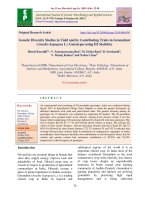


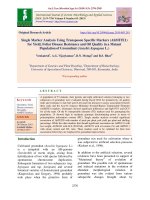
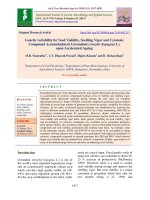
![Generation mean analysis using six parameters genetic model for quantitative traits in cowpea [(Vigna unguiculata (L.) Walp.]](https://media.store123doc.com/images/document/2020_01/14/medium_ccw1578956370.jpg)
